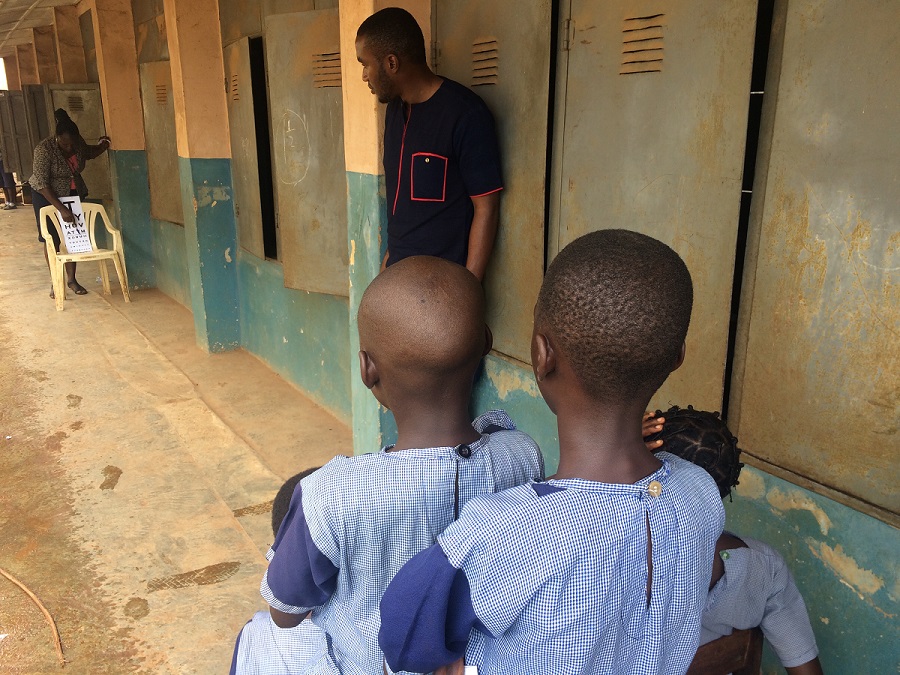Join the Leading Global Eye Health Alliance.
Membership-
Choose an alternate language here

Background
There is substantial evidence that refractive error remains the most common cause of visual impairment among school –going children[1][2][3][4]. The prevalence of visual impairment caused by refractive error in school going children in Nigeria is estimated to be 5 – 8%[5][6] and even higher in older children, 10 to 11 years and above[7][8][9].
For younger school children, the most prevalent eye conditions found were allergic conjunctivitis and corneal opacities[10]. The Seeing Is Believing Comprehensive Child Eye Health in Nigeria programme (2017 to 2020) has as one of its 6 objectives to establish a school eye health programme as a sustainable model to deliver eye health services to children. However, the unavailability of school health nurses in the system poses a challenge in establishing school health programmes in Akwa Ibom and Cross River States, where Seeing is Believing is working. A strategy to utilize available eye care personnel within the public sector to deliver a coordinated and effective school eye health service to the most vulnerable school going children was implemented[11].
Secondary school approach (children are aged 9 and above)
Eye screening tests of all students took place in their schools for detection of uncorrected refractive error. The form teachers were trained by visiting optometrists to conduct vision screening using the 5 “Es” the size of 6/12 row, 3 meter twig for measuring distance accurately and pen torches for external eye assessments. Each form teacher carried out the exercise with 30-40 children per class during an extended break period. Children who failed the screening tests were issued referral letters to their parents for full eye examination. Children who required spectacles and other forms of treatment were provided.
Primary school approach (children are aged 4 years to 11 years)
Ophthalmic nurses in pairs of 12 teams visited the primary schools to carry out eye health assessments on each child using the pen torch. Simple eye conditions (allergic and bacteria conjunctivitis) were treated on the spot. Children who required treatment received eye medications, already labelled with instructions to parents on how to apply the drops. Children who self-reported eye problems, and children whose form teachers suspected them of having eye problems, were referred for full eye examination at the child eye clinics already equipped by the programme. As a result, between the months of March 2019 and June 2019, 198,436 children had been screened; achieving 67.6% of the total project output. Eye medications were dispensed to 11,100 children, and 2,319 spectacles were dispensed accounting for 51.3% of planned output for the two states under the programme.
The approaches targeted prevalent eye conditions at the different age groupings/ school levels and proved to be effective in identifying children most at risk of eye conditions by statistical evidence. Available skilled eye care personnel were engaged appropriately. The model minimises over-referrals, often associated with school vision screening in younger school children, and is a viable option for Government to adopt in the absence of school health nurses.
Conclusion and recommendation
Anne Ebri,
Brien Holden Vision Institute
Nigeria
[1] Resnikoff S, Pascolini D, Mariotti SP, Pokharel GP. Global magnitude of visual impairment caused by uncorrected refractive errors in 2004. Bull World Health Organ [Internet]. 2008 [cited 2015 Oct 16];86(1):63–70. Available from: http://www.scielosp.org/scielo.php?script=sci_arttext&pid=S004296862008000100017&lng=en&nrm=iso&tlng=en
[2] Kumah BD, Ebri A, Abdul-kabir M, Ahmed A, Koomson NY. Refractive Error and Visual Impairment in Private. 2013;90(12):1456–61.
[3] Paudel P, Ramson P, Naduvilath T, Wilson D, Phuong HT, Ho SM, et al. Prevalence of vision impairment and refractive error in school children in Ba Ria – Vung Tau province, Vietnam. Clin Exp Ophthalmol. 2014;42(3):217–26.
[4] Zhao J, Mao J, Luo R, Li F, Munoz SR, Ellwein LB. The progression of refractive error in school-age children: Shunyi district, China. Am J Ophthalmol. 2002;134(5):735–43.
[5] Ayanniyi A., Mahmoud A., Olatunji F. Causes and Prevalence of Ocular Morbidity among Primary School Children in Ilorin, Nigeria [Internet]. Vol. 13, Nigerian Journal of Clinical Practice. Medical and Dental Consultants’ Association of Nigeria (MDCAN); 2010 [cited 2015 Nov 28]. Available from: http://www.ajol.info/index.php/njcp/article/view/59702
[6] Ajaiyeoba AI, Isawumi MA, Adeoye AO, Oluleye TS. Pattern of eye diseases and visual impairment among students in southwestern Nigeria. Int Ophthalmol. 2007 Sep;27(5):287–92.
[7] Balarabe A, Adamu I, Abubakar A. Vision screening to detect refractive errors in three selected secondary schools in Birnin Kebbi, North West, Nigeria. Sahel Med J [Internet]. 2015;18(2):61. Available from: http://www.smjonline.org/text.asp?2015/18/2/61/160799
[8] He M, Huang W, Zheng Y, Huang L, Ellwein LB. Refractive Error and Visual Impairment in School Children in Rural Southern China. Ophthalmology. 2007;114(2):374–83.
[9] Opubiri I, Pedro-Egbe C. Screening for refractive error among primary school children in Bayelsa state, Nigeria. Pan Afr Med J. 2013;14(1).
[10] Ajaiyeoba AI, Isawumi MA, Adeoye AO, Oluleye TS. Pattern of eye diseases and visual impairment among students in southwestern Nigeria. Int Ophthalmol. 2007 Sep;27(5):287–92.
[11] World Health Organisation. Vision 2020, The right to sight:Global initiative for the elimination of avoidable blindness. Action Plan 2006-2011. 2007;